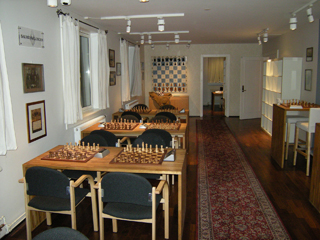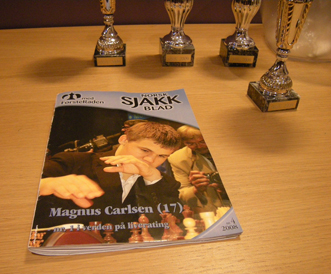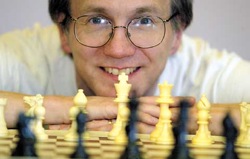I’m back from my two-week trip from Norway! It was a business trip, of course, so I didn’t get to play nearly as much chess as I had hoped, but nevertheless I have a few pictures to show you.
First, here is a quiz. Can any of you identify what famous chess game the moves in the photograph were taking from?
I saw this storefront a week ago last Sunday, as I was strolling around an area of Oslo called Grünerløkka, which as one guidebook told me, roughly translates into “Greenwich Village.” Sort of a funky area of small shops and restaurants that aren’t quite as expensive as in the main tourist areas. I knew that there were several chess clubs in Oslo, but nevertheless I was shocked to find that one of them actually had a storefront of its own, with this beautiful sign etched in glass. Of course, I was equally shocked to see that somebody had defaced it with graffiti. Although “I Love Bambi” isn’t the worst thing that anyone could have written there, still I hope the Stjernen Sjakklubben will find a way to remove the graffiti without damaging the game.
Unfortunately the club wasn’t open that day — only on Tuesday and Thursday evenings and Saturday all afternoon. I intended to go back at one of those times, but I had too much work and was never able to.
However, I did get a chance on Wednesday night to visit the main Oslo Chess Club. Unlike the Stjernen club, the Oslo Chess Club is not visible from the street — you have to know where you’re going. At 30 Bogstadveien, which is right in the middle of a very fashionable shopping district, you take an elevator up to the seventh floor, and once there you go through a door and find yourself in this beautiful long hall.
As a long-timer at the club explained to me, a former member gave the club a gift or bequest in 1916 that would be worth about half a million kroner today. The club used it to buy the entire seventh floor of this building. It’s got to be one of the most comfortable and well-equipped chess clubs I have ever seen. It’s more or less in a U-shape. At the end of this long hall there is a shorter room that opens to the right, and then at the end of that one is another long hall that runs parallel to this one. I don’t know how many games they can have going at the same time, but I would guess at least fifty or sixty. Notice that the sets are all made of wood. Notice the beautiful track lighting. Notice the luxurious carpet. Verily, this is a chess palace!
Unfortunately, this chess palace is somewhat under-utilized. Oh, it’s open five nights a week, but most nights the only activity is league matches or a club tournament. You don’t get anybody who comes, as I did, just to drop in and play some chess for fun. The old-timer (whose name I unfortunately did not learn; he is the man at left in the photograph below) said, “You came to this club 50 years too late.” Fifty years ago, he said, the hall would have been packed end to end with people playing chess and smoking cigars, and you would not have been able to see all the way to the end because of the smoke. Well, I’m glad the smoke has cleared, but not so glad that the players have cleared out as well!
Left, the friendly man who explained to me the history of Oslo Chess Club. Right, a player whose name I think was Daniel. He thought he recognized me from the Isle of Man chess tournament, but I told him no, I haven’t even been outside the U.S. for eight years!
On the evening I was there, two five-board team matches were taking place, and I watched them for a while, but otherwise the place was almost empty. There were a few kids having fun in the front room:
The shorter room, at the bottom of the U shape, had pizza boxes and sodas in it, because the people playing the team matches had gathered for pizza beforehand. It also had a very nice wide-screen TV that, at the time I was in there, showed Oprah Winfrey talking with Norwegian subtitles! I wish I had taken a photograph of that.
I did finally get to play a few games, with a guy named Sverre Johnsen who (according to the friendly old-timer) was the caretaker of the club. Sverre had a little three-year-old boy named Malk, I believe, who doesn’t play chess yet but spends so much time at the club that he’s sure to turn into a good player! According to the old-timer, Sverre is already planning to enter him in tournaments as soon as he gets old enough (age five).
Sverre’s current FIDE rating is 2172, and he has co-written three books with grandmasters. One of them was about the London System, so when he played 1. d4 Nf6 2. Bf4 against me I decided I’d better shake things up with 2. … Nh5! It actually worked — I won that game. He won the other six blitz games that we played, but except for two that I spoiled with horrible blunders, I think the others were very competitive and interesting and could have gone either way.
As I mentioned in my previous entry, I was unbelievably nervous during these games, and I don’t know why. Maybe being in a foreign country makes me feel under scrutiny somehow (even though nobody was watching!). I have definitely noticed that it makes me more clumsy. It’s as if my lack of ability to understand the language or the local customs translates into acting stupid in other ways. I trip over things. My English speaking also deteriorates. Somehow I feel a lot of psychological pressure. I would like to play in a tournament abroad sometime, but I think it’s clear that I need to prepare psychologically before I do so.
However, in spite of that, I was very glad that I came to the Oslo Chess Club. It was a nice change to spend the evening talking and playing chess with some Norwegians instead of spending it holed up in my hotel room, typing transcripts of the interviews I had done that day.
There was one more thing I was curious about: had Magnus Carlsen ever been to the Oslo Chess Club?
Norway’s chess celebrity.
Not for quite a long time, I was told. However, he did come–along with his brother, who probably no longer plays chess–as a very little kid, maybe five years old, and even then one of the club’s strong masters said that he thought this kid was going to be something special someday.
If Carlsen ever gets to play for the world championship, could there be a “Carlsen boom” in Norway like the “Fischer boom” that took place in the U.S. in 1972? Perhaps the Oslo club ought to start making plans for events that could take advantage of Carlen’s name recognition and visibility. But maybe it wouldn’t work, because Norwegians are so laid-back and not into the culture of celebrity. “There is the King, and after that everybody else in Norway is equal,” one person told me.








{ 8 comments… read them below or add one }
Sverre’s blog is here: http://sverreschesscorner.blogspot.com/
Anderssen-Kieseritzsky! Strange that 18.Bd6 gets the ?? while Black’s moves aren’t criticized.
Hello
Nice Blog!
Just a few additions/corrections:
– The friendly old-timer’s name is John Kristian Johnsen (no relative of me).
– My son’s name is Jonatan (malk or maak means ‘a lot’ in his mother’s tongue).
– Magnus didn’t play much chess when he was 5 years old – he only started when 6 or 7 years old.
– Magnus played the club championship in Oslo Schakselskap not too long ago – maybe in 2004 or 2005.
– Magnus doesn’t have any brothers but three sisters (one older and two younger) who all still play chess.
Just a few more details:
– The Oslo Chess Club is open seven days a week (not five).
– The young man who thought he had seen you in Isle of Man is named Daniel Kovachev
– The Norwegian king isn’t that special. He is just a bit more equal than the rest of us.
Hello again
I just had a quick chat with John Kristian. It seems that what you thought was a name ‘malk’ really was the Norwegian word ‘melk’ which means milk (still a favorite drink of Jonatan).
Sverre,
Thanks for writing! I enjoyed meeting you, and I also very much enjoyed getting to look at your blog. I see that it is no surprise that our last game began 1. d4 Nf6 2. Nc3 d5 3. Bg5 Nbd7 4. Qd3, as that is discussed at length in your blog. It’s a line I really need to study.
I appreciate all the corrections. Obviously I wrote the entry based on what John Kristian told me and what I remembered, and it is quite possible that either he said things (in English) that weren’t quite correct or that I didn’t interpret what he said correctly. It’s very easy for things like that to happen!
Sorry about getting your son’s name wrong! I thought you said something about “that’s his name” at some point, and I thought it was a little odd for him to be named after milk, but thought it was interesting. But maybe you were just saying that it was his favorite. It’s pretty confusing to try to understand a 3-year-old’s conversation and play a game of chess at the same time! Anyway, I thought that *Jonatan* was a lot of fun — a real bundle of energy!
Aziridine — Correct! I didn’t figure this out until I looked at the window where the game begins. They still didn’t identify the players, but when I saw the first few moves I knew that it had to be the “Immortal Game.”
Yes, that 18. Bd6?? is somewhat odd. Why would you want to memorizlize a game where the winner plays a terrible blunder? But my guess is that modern analysis (maybe with computers?) must have shown that this was a place where Anderssen’s combination has a fatal gap. Does anyone know?
Still, Aziridine has a point, that Black must have made a compensating mistake, since he went on to lose the game.
The Immortal Game was infamously annotated by Huebner, who not only pointed out that White (and Black) made numerous mistakes during the game but that there were at least three moves stronger than 18.Bd6 he could have chosen, if I recall correctly. I forget what the flaw of that move was though.
I guess the Manhattan CC (is it still alive?), Memphis CC (Tennessee), Marshall CC (New York) or the Mechanics Institute CC (San Francisco). The Memphis Chess Club opened in 1877 (closed due to city wide iellnss), then reopened in 1901. Does the club need to be continuous? The Kansas City Chess Club (Missouri) is old, but not continuous.
{ 3 trackbacks }